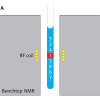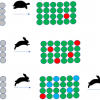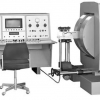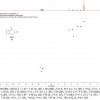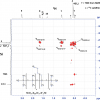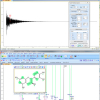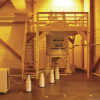Claudia Schmidt
Department of Chemistry, University of Paderborn, Warburger Straße 100, 33098 Paderborn, Germany. E-mail: [email protected]
Introduction
Soap solutions, lotions and creams, paints, many foods, biological fluids–all these materials belong to the class of complex fluids. They show a flow behaviour that can be very different from that of a simple Newtonian liquid like water. The peculiar flow properties of complex fluids result from their complex structure and dynamics that are characterised by a hierarchy of length and time scales. Understanding the flow of complex fluids is important so products can be optimised with respect to both performance (paint should be easily applicable but should not drip) and processing (flow through pipes in manufacturing should require minimum energy). Rheology, the science of deformation and flow, provides experimental tools that yield information on macroscopic properties such as viscosity and modulus. However, in order to tailor the rheological properties of materials an understanding at a molecular level is necessary. This has stimulated the development of a research area called rheo-physics, in which methods for the investigation of molecular and microscopic structure and dynamics are applied in situ under flow conditions. Rheo-NMR (rheo-nuclear magnetic resonance) is part of this field of research.1,2
NMR has several advantages. It does not require transparent samples, in contrast to most rheo-optical techniques. No special probes need to be added to the sample, which may change the rheological properties. Perhaps the biggest advantage of NMR is its versatility. Hundreds of different NMR methods are available, a plethora yet to be exploited for rheo-NMR, although a commercial rheo-NMR accessory has been available for about 10 years. NMR provides tools for spectroscopy, imaging (MRI, tomography) and velocimetry.
In this article, the focus is on some of our work using 2H rheo-NMR spectroscopy to investigate shear flow. This method provides interesting information even in the absence of spatial resolution. Some recent rheo-NMR developments will be mentioned as well. More comprehensive review articles, covering imaging and velocimetry as well, have been written, for example, by Paul Callaghan.1,2
Experimental

In Figure 1, the principle of the most common shear geometries used in rheo-NMR is shown. Both the cone-and-plate and the cylindrical Couette geometry (designed for laminar flow) have an axis of symmetry which is aligned along the magnetic field B. The two geometries differ by the orientation of the magnetic field with respect to the local coordinate frame of shear { xyz }, providing complementary information about shear-induced sample alignment. The dimensions of rheo-NMR cells are a consequence of a compromise between the requirements of shear (narrow gap to achieve homogeneous stress) and NMR (wide gap for better filling factor). Typical cells have outer diameters between 1 cm and 2 cm, gap angles of about 5° (cone and plate) and gap diameters of about 1 mm (Couette). The shear cell is surrounded by the NMR coil (often a bird cage resonator) and its rotating part is connected via a drive shaft to a motor located below or on top of the magnet Dewar.
Liquid-crystalline polymers
Thermotropic and lyotropic liquid-crystalline phases are anisotropic even at rest, while other complex fluids, such as polymers and surfactant solutions, may become anisotropic only under shear. Therefore, the measurement of shear-induced orientations is one of the most prominent goals of rheo-NMR. 2H NMR spectroscopy is most suitable for studies on liquid crystals since the residual quadrupole coupling of the deuterium nucleus (spin quantum number I = 1) leads to a spectral doublet with a frequency splitting, given by Dn = 3/4 dQ (3 cos2q - 1) in a uniaxial phase. The factor dQ represents the time-averaged quadrupole coupling constant and q is the angle between the magnetic field and the director (symmetry axis) of the liquid-crystalline phase.
Nematic phases, which are characterised by a preferred orientation of the molecules along the director axis, can show two types of flow behaviour. They can be of either the flow-aligning or tumbling type. The former ones adopt a stable orientation in shear flow and can be uniformly aligned on a macroscopic scale, whereas tumbling nematics rotate continuously under shear, which leads to spatio–temporal patterns of the director orientation. Knowledge of the flow response is relevant for optimising processing conditions, in particular of liquid-crystalline polymers, since, depending on the flow-induced macroscopic state of orientation, quite different optical and mechanical properties will result.
Liquid crystals are also aligned by magnetic fields. In the strong field of an NMR magnet very high shear rates are necessary to realign the director of a low molar mass liquid crystal. For the more viscous polymeric liquid crystals moderate shear rates in a range easily accessible with rheo-NMR equipment are sufficient. In this case, the competition between magnetic field and shear can be used for characterising the flow behaviour in a quantitative way.3,4
As an example, results obtained for two nematic liquid-crystalline polysiloxanes are shown on the left of Figure 2.3,4

The shear-rate dependent director orientation q was calculated from the quadrupole splitting Dn of 2H NMR spectra obtained in cone-and-plate geometry. At very low shear rates the magnetic field wins the competition against the shear force and the director remains aligned close to the magnetic field axis (small values of q). As the shear rate is increased the director changes its orientation due to the increasing viscous torque. In the case of the flow-aligning polymer (red data points) a limiting angle close to the flow direction (Leslie angle) is reached at high shear rates. The second polymer (blue data points), the chemical structure of which differs only by the length of the spacer (number of CH2 units in the side chain), behaves differently, revealing the tumbling character of this material. A uniform orientation of this polymer is achieved only at low shear rates, when tumbling is suppressed by the magnetic field. Above a critical shear rate, tumbling sets in and a powder line shape, representing the distribution of director orientations, is observed. The tendency towards tumbling becomes weaker at higher temperature. Measurements on a large number of liquid-crystalline polysiloxanes revealed that the tumbling instability occurs when smectic clusters are present in the nematic phase, a correlation also known for low molar mass nematics. Based on these findings, tuning of the flow-behaviour of side-chain liquid-crystalline polymers becomes possible not only by changing the temperature but also by adjusting the composition of random copolymers made from two slightly different monomers.4
While thermotropic liquid-crystalline polymers require selective deuteration of the molecules, in lyotropic systems a deuterated solvent (often water) may serve as a probe of the director orientation. A detailed rheo-NMR study using D2O on the shear-induced states and the director relaxation upon cessation of shear in Couette geometry was carried out for the lyotropic liquid-crystalline polymer hydroxpropylcellulose in aqueous solution by Geng and co-workers.5
The smaller quadrupole splitting of solvent molecules, due to their lower residual order, results in spectra with a highly improved signal-to-noise ratio. This makes time-resolved experiments possible. An example can be seen on the right of Figure 2, where time-resolved D2O spectra measured by Isabel Quijada-Garrido from Institute of Polymer Science and Technology, Madrid, Spain, and Nikolay Sinyavsky from Baltic State Academy, Kaliningrad, Russia, for an aqueous solution of wormlike surfactant micelles (“living polymers”) after start-up of shear are depicted.
Lyotropic lamellar phase
Among lyotropic liquid crystals the lamellar phase (La), often found in aqueous surfactant solutions, is the most interesting one. Lamellar structures are also formed by lipids and play an important role in living organisms. The La phase can consist of stacks of more or less flat extended bilayers or of densely packed multilamellar vesicles. The vesicle state is of interest for drug delivery or as microreactor. Shear has a strong influence on the orientation and morphology of the lamellar phase. The best-studied lamellar system under shear is a 40 wt % solution of the non-ionic surfactant C10E3 (triethylene glycol mono-n-dodecyl ether) in D2O.6,7 In this system, shear-induced multilamellar vesicles are formed at low temperatures and sufficiently high shear rates, whereas at higher temperatures and lower shear rates the steady state consists of aligned layers. Bruno Medronho and co-workers investigated how one state is transformed into the other by shear.6 Their rheo-NMR results obtained in Couette geometry are shown in Figure 3. The evolution of the spectra with time (proportional to strain) reveal a continuous transformation from aligned layers to multilamellar vesicles, but a discontinuous process, with a coexistence of the two states, for the opposite direction, when vesicles are transformed into aligned layers. Additional 2H rheo-NMR experiments with spatial resolution, carried out at Victoria University, Wellington, New Zealand, have shown that the former transformation proceeds homogeneously throughout the sample whereas the transformation from multilamellar vesicles to aligned layers begins at the inner moving wall of the Couette cell and propagates to the outer wall.7

Recent developments
The 1H nucleus is also used frequently in rheo-NMR spectroscopy. Due to residual dipolar couplings 1H spectra are often broad and featureless but relaxation can provide information on the sample. 1H NMR is a tool easy to use for detecting transitions from liquids to solids by simply monitoring the disappearance of the narrow lines of the liquid components. For instance, Ohgo et al. monitored the time dependent 1H spectra of silk fibroin in D2O as solvent.8 The researchers observed a decrease of signal intensity due to the shear-induced formation of silk aggregates which form when the silk molecules are transformed from random coils to b-sheets.
A very interesting nucleus for rheo-NMR was introduced by Galina Pavlovskaya and Thomas Meersmann.9 They used the quadrupole coupling of 23Na (spin I = 3/2) to investigate flow-induced alignment in a solution of the polysaccharide xanthan in tubular flow. The weak alignment of this non-liquid-crystalline polymer cannot be detected in the single quantum 23Na spectrum (or in the 2H NMR spectrum of the solvent). However, use of a special pulse sequence yields a magic angle double-quantum filtered spectrum only if a residual quadrupole coupling exists, even if the coupling is very small. In isotropic solution the double-quantum filtered spectrum disappears. This is a promising technique for rheo-NMR applications because of the abundance of 23Na, in particular in biological samples.
Still a challenge in rheo-NMR is the simultaneous measurement of rheological and NMR parameters. In such combined experiments either the NMR measurement or the rheological measurement can be optimised. An early example of the former approach was realised by David Grabowski at the University of Freiburg, Germany, who used a shear cell with a home-built torque sensor.3 This enabled the simultaneous measurement of shear viscosity during the NMR experiment. For proof of principle the flow-aligning liquid-crystalline polymer discussed above was used, cf. Figure 2. In the presence of the magnetic field, a change of viscosity as a function of shear rate is observed, due to the change in director orientation. When the NMR probe is taken out of the magnet, however, the viscosity is independent of the shear rate since the director aligns at the Leslie angle already at low shear rates. Recently, a more flexible and easy to use rheo-NMR device with a torque sensor has been developed in the group of Petrik Galvosas at Victoria University, Wellington, New Zealand.10
The second approach, which enables high-end rheological experiments, is undertaken by Manfred Wilhelm and his group at Karlsruhe Institute of Technology, Germany. They use a Halbach-type magnet similar to the one described in Reference 11, which consists of an assembly of small permanent magnets arranged around a shear cell that is connected to a commercial rheometer. Thus low-field low-resolution 1H-NMR relaxation spectroscopy can be combined with various rheological experiments including measurements of the complex shear modulus under oscillating shear.
References
- P.T. Callaghan, “Rheo-NMR: nuclear magnetic resonance and the rheology of complex fluids,” Rep. Prog. Phys. 62, 599670 (1999). doi: http://dx.doi.org/10.1088/0034-4885/62/4/003
- P.T. Callaghan, “Rheo-NMR and velocity imaging,” Curr. Opin. Colloid Interface
Sci. 11, 1318 (2006). doi: http://dx.doi.org/10.1016/j.cocis.2005.10.003 - D.A. Grabowski and C. Schmidt, “Simultaneous measurement of shear viscosity and director orientation of a side-chain liquid-crystalline polymer by rheo-NMR,” Macromolecules 27, 26322634 (1994). doi: http://dx.doi.org/10.1021/ma00087a037
- H. Siebert, I. Quijada-Garrido, J. Vermant, L. Noirez, W.R. Burghardt and C. Schmidt, “Director orientation of nematic side-chain liquid crystalline polymers under shear flow: comparison of a flow-aligning and a non-flow-aligning polysiloxane,” Macromol. Chem. Phys. 208, 21612172 (2007). doi: http://dx.doi.org/10.1002/macp.200700248
- Y. Geng, P.L. Almeida, G.M. Feio, J.L. Figueirinhas and M.H. Godinho, “Water-based cellulose liquid crystal system investigated by rheo-NMR,” Macromolecules 46, 42964302 (2013). doi: http://dx.doi.org/10.1021/ma400601b
- B.F. Medronho, S. Shafaei, R. Szopko, M.G. Miguel, U. Olsson and C. Schmidt, “Shear-induced transitions between a planar lamellar phase and multilamellar vesicles: continuous vs. discontinuous transformation,” Langmuir 24, 64806486 (2008). doi: http://dx.doi.org/10.1021/la800326a
- B.F. Medronho, U. Olsson, C. Schmidt and P. Galvosas, “Transient and steady-state shear banding in a lamellar phase as studied by rheo-NMR,” Z. Phys. Chem. 226, 12931313 (2012). doi: http://dx.doi.org/10.1524/zpch.2012.0313
- K. Ohgo, F. Bagusat, T. Asakura and U. Scheler, “Investigation of structural transition of regenerated silk fibroin aqueous solution by rheo-NMR spectroscopy,” J. Am. Chem. Soc. 130, 41824186 (2008). doi: http://dx.doi.org/10.1021/ja710011d
- G.E. Pavlovskaya and T. Meersmann, “Spatial mapping of flow-induced molecular alignment in a noncrystalline biopolymer fluid using double quantum filtered (DQF) 23Na MRI,” J. Phys. Chem. Lett. 5, 26322636 (2014). doi: http://dx.doi.org/10.1021/jz501075j
- T. Brox and P. Galvosas, Rheological Measurement Device with Torque Sensor. NZ and PCT Patent Application (2014).
- K.F. Ratzsch, R. Kádár, I. F.C. Naue and M. Wilhelm, “A combined NMR relaxometry and surface instability detection system for polymer melt extrusion,” Macromol. Mater. Eng. 298, 11241132 (2013). doi: http://dx.doi.org/10.1002/mame.201300243



